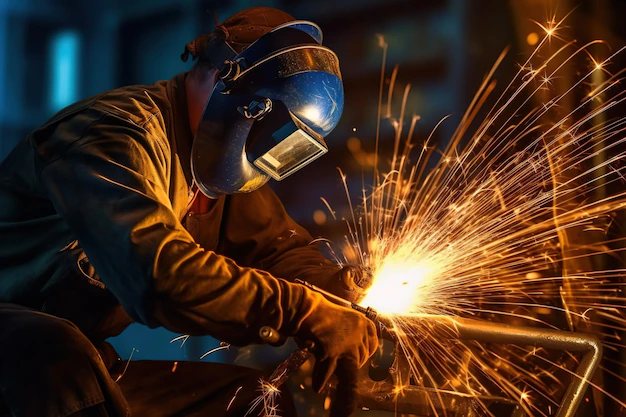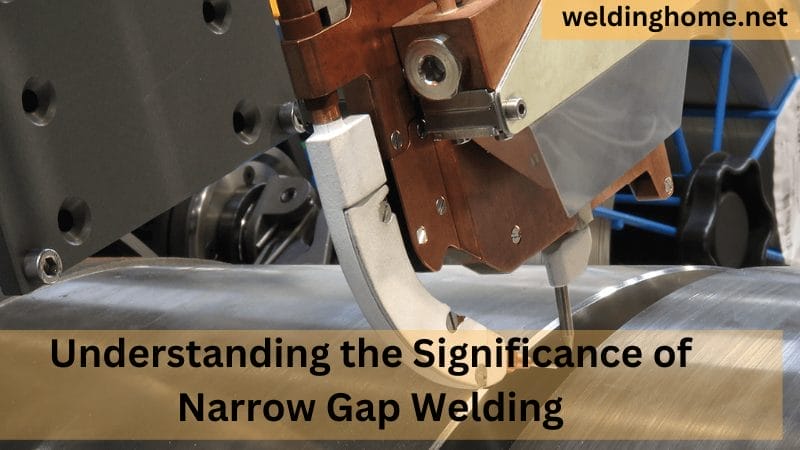What is Flux-Core Arc Welding (FCAW), And How Does it Work?

Introduction
What is Flux-Core Arc Welding (FCAW), And How Does it Work? (FCAW) is an active and essential method for joining and making things out of metal. This new way of welding has changed how pros join metals together robustly and reliably. In this piece, we will go deep into the world of FCAW, figuring out its complexities and showing how important it is in many different businesses.
FCAW means for Flux-Core Arc Welding. It is a popular choice among welders worldwide because of its unique way of welding. FCAW is different from other ways of welding because it uses a particular circular wire electrode filled with flux material. This flux keeps the weld pool from getting dirty and improves the join by adding more alloying elements.
As we go through this piece, I will look at the basics of FCAW, including its parts, how it works, its pros and cons, and the many ways it can be used. Flux-Core Arc Welding is a valuable skill to have if you want to learn more about welding or if you want to improve your welding skills.
How Does Flux-Core Arc Welding (FCAW) Work?
Flexible and economical Flux-Core Arc Welding (FCAW) is used in metal manufacturing. It is arc welding, which bonds metals using an electric arc. The “flux-core” tubular wire electrode characterizes FCAW.
FCAW relies on flux material in the wire electrode. This flux has various vital welding activities. First and foremost, it shields the molten weld pool from oxygen and nitrogen, which might weaken the weld. The flux also adds alloying components to the weld, improving its mechanical qualities.
Due to its self-shielding qualities, FCAW is ideal for outdoor welding without shielding Gas. It is common in construction, shipbuilding, and other sectors requiring welding in less regulated situations.
Flux-Core Arc Welding is a solid and efficient welding process that welders may use on many tasks.
Components of FCAW
- The welding arc requires electricity from the power source.
- The wire feeder feeds the continuous flux-core wire spool into the welding gun at a regulated pace.
- Welding Gun: Holds the electrode and directs the arc.
- The welding process relies on the flux-filled wire electrode.
- An external shielding gas may improve the welding process; however, FCAW is generally self-shielding owing to flux.
- These components cooperate flawlessly to provide Flux-Core Arc welding success, enabling fast metal joining and manufacturing.
What method is used in FCAW welding?
Flux-Core Arc Welding (FCAW) uses arc welding. FCAW welds by producing a molten metal pool using an electric arc. Like GMAW and SMAW, This method uses an electric spark between an electrode and the metal piece to join them. FCAW uses a tubular wire electrode packed with flux material to protect and alloy the weld.
How does FCAW work?

Certainly! The operational procedure of Flux-Core Arc Welding (FCAW) may be briefly described sequentially:
Wire Feed
The wire feed process involves continually feeding a spool of flux-core wire into the welding gun.
Electric Arc Initiation
The initiation of an electric arc occurs when the trigger is activated, generating an electrical discharge between the wire and the underlying substrate.
Wire Melting
A liquid metal pool forms due to the flux-core wire going through a phase transition due to the electric arc’s thermal energy.
Shielding and Flux Activation
The process involves the melting of the flux present in the wire electrode, which subsequently releases shielding gases. These gases serve the purpose of safeguarding the weld from any potential contamination.
Fusion
Fusion occurs when the molten wire combines with the base metal, forming a robust, uninterrupted weld bead.
Solidification
Solidification occurs as the welding process progresses and the temperature decreases, forming a robust, long-lasting junction.
As mentioned, the procedure exhibits high efficacy in the fusion of metallic materials and is renowned for its adaptability, rendering it a preferred option in diverse welding scenarios.
The Mechanics of Flux-Core welding

Basics of FCAW: FCAW is a form of arc welding that employs an electric discharge to heat metals and create robust welds.
Unique reusable: FCAW uses a particular reusable electrode called a flux-core wire. The open centre of this wire is filled with flux material.
Flux does two crucial things: It acts as a cover and strengthens the metal. It keeps toxins from getting into the weld and adds more alloying elements to improve the quality of the weld.
Continuous Feeding: When welding, flux-core wire is constantly fed into the welding area, where it melts and forms a pool of molten metal that holds the metals together.
Self-Shielding and Gas-Shielding: There are two main types of FCAW: self-shielding, which uses flux as a shield, and gas-shielding, which uses a shielding gas from the outside to get precise results.
Synergy of Elements: The FCAW works well because the electric arc, flux-core wire, and protective gases work together. This makes it possible to make solid and effective welds for various uses.
Advantages of FCAW
- FCAW welds quicker than conventional techniques, enhancing productivity.
- It penetrates the base material deeply for solid welds.
- Flux makes FCAW self-shielding, making it suited for outdoor and windy environments.
- It welds tiny sheets into thick plates.
- FCAW generates less slag, requiring less post-weld cleaning.
- It may be utilized above or vertically, giving it versatility.
- High deposition rates and low equipment requirements make the process cost-effective.
- FCAW’s self-shielding features prevent hydrogen-induced weld cracking.
- It’s simpler to learn and master than other welding methods, making it accessible to more welders.
- FCAW is good at welding heavier materials, making it ideal for heavy-duty applications.
- These benefits make flux-core arc welding a popular welding method in many sectors.
Limitations of FCAW
Here are some Flux-Core Arc Welding (FCAW) limitations:
- Welding thin materials with FCAW may cause burn-through or deformation.
- It produces more spatter than conventional welding procedures, requiring more cleaning.
- FCAW may need to be more precise for delicate welding patterns or exquisite art.
- Uncontrolled gases and smoke may pose health and environmental risks.
- FCAW equipment might be bulkier and less portable for heavy-duty applications than other welding systems.
- FCAW welds may not be as attractive as TIG welds.
- FCAW’s rapid deposition rates may make deposition rate control difficult, causing buildup.
Welders must understand these restrictions to decide when and when to use Flux-Core arc welding.
Common Applications of FCAW
Here are some popular Flux-Core Arc Welding (FCAW) uses in bullet points:
- The construction sector uses FCAW to weld structural steel, bridges, and building frames.
- Shipbuilding: It joins steel plates to produce robust ships.
- FCAW makes bulldozers, cranes, and excavators.
- FCAW welds pipes, notably oil and gas pipelines.
- It is used to weld chassis, frames, and other automobile components.
- Aerospace Manufacturing: FCAW welds landing gear and structural sections.
- FCAW can repair heavy equipment, agricultural machinery, and industrial infrastructure.
- In mining, it’s utilized for welding equipment for excavation, drilling, and transporting.
- FCAW is used in small and large fabrication operations for bespoke metalwork and component manufacture.
FCAW’s self-shielding qualities make it excellent for outdoor welding, where wind and weather might disrupt the operation. These numerous applications demonstrate Flux-Core Arc Welding’s adaptability and efficacy across sectors.
Safety Precautions in Flux-Core Arc Welding
Ensuring safety is of utmost importance in any welding procedure. Welders must don suitable protective equipment, establish enough ventilation, and know about possible welding risks, including arc flash and fume exposure.
Choosing the Right FCAW Equipment
The right FCAW equipment consists of the following components and considerations:
- Power Source
- Wire Feeder
- Welding Gun
- Flux-Core Wire Electrode
- Shielding Gas (if applicable)
- Voltage Settings
- Wire Feed Speed
- Maintenance
- Training
- Safety Equipment: Ensure you have the necessary safety gear, including a welding helmet, gloves, protective clothing, and safety glasses, to protect yourself during welding.
- Accessories: Consider additional accessories such as contact tips, nozzles, and liners that may be required for specific welding tasks.
Choosing the right FCAW equipment is crucial for achieving successful welds and ensuring the safety of the welding process.
Tips for Successful FCAW Welds
- It is essential to adhere to a regular velocity when traveling.
- Maintain the appropriate angle of the welding gun.
- It is essential to thoroughly cleanse the base material before engaging in the welding process. Additionally, closely monitoring the welding parameters for optimal results is essential.
Conclusion
Flux-Core Arc Welding (FCAW) is a powerful welding method that has shaped several sectors. FCAW precisely and powerfully fuses metals using electric arcs, flux-core wire, and shielding gases.
Its self-shielding or gas-shielding versatility makes it popular in construction, shipbuilding, and aerospace production. Its rapid deposition rates, simplicity of application, and superior penetration make it a reliable welding method.
The science underpinning FCAW isn’t only its mechanics; it opens up unlimited possibilities. Weld by weld, FCAW shapes the world, from buildings to aircraft technology.
FCAW represents innovation and scientific knowledge as the welding industry evolves. It shows that welding accuracy and dependability are attainable. Welders may push the limits of what is possible by adopting FCAW technology, creating a legacy of strength, durability, and quality.
FAQ’S
Are both novice and seasoned welders able to use flux-core arc welding?
Yes, novices can learn FCAW, and expert welders also utilize it because of its effectiveness.
For what use do several flux-core wire kinds exist?
Yes, several flux-core wires are made for specific materials and uses.
What safety equipment do I need to use during flux-core arc welding?
A welding helmet, gloves, coveralls, and safety glasses are all examples of safety equipment.
Can underwater welding be done using flux-core arc welding?
If you have the right tools and expertise, you can weld underwater.
How can I make FCAW less spatter?
Spatter may be decreased by modifying the welding settings and keeping the proper gun angle.






